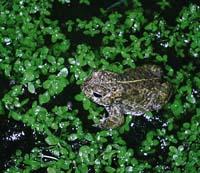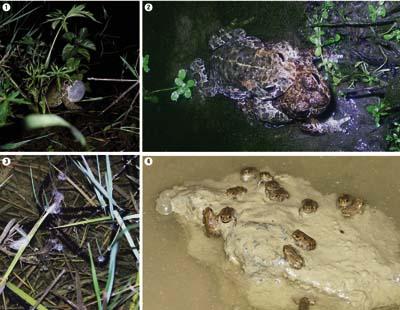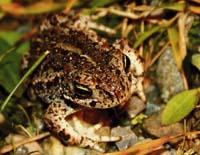An athlete on the beach
2006/03/01 Garin, Ion - ARANZADI Zientzi Elkarteko biologoa | Gosá, Alberto - ARANZADI Zientzi Elkarteko biologoa | Rubio, Xabier - ARANZADI Zientzi Elkarteko biologoa | San Sebastián, Olatz - ARANZADI Zientzi Elkarteko biologoa Iturria: Elhuyar aldizkaria

To cope with the dangers and avoid competition with other gallons, the sapo runner developed differentiated athletic characteristics: shorter legs than normal and abnormal vitality. These features made it a high-speed corridor of small distances. This allows the toad to avoid the first bite, even to avoid the second and then jump to a nearby surface well. With a little luck, the predator opposes to enter the water.
In addition to escaping, he runs in other situations. For example, in search of shade to walk from stone -- from plastic to brick today --. It lives in open and sunny areas. However, running has become a characteristic of the species.
It would probably also reach Europe. Originally from Asia, it currently lives in Western Europe, being the Mediterranean climate of the Iberian peninsula that it likes the most. However, it can also be found in areas with more humid and fresh climates, as well as in higher latitudes. This is due to the entry by the north and climate change in the peninsula. These populations are of great value in the Iberian peninsula.
In Euskal Herria, in two places
The sapo corridor lives in two areas in Euskal Herria, in very different situations in terms of number of living beings and occupied surface. In the Ebro basin there is a normal population --mediterranean - apparently healthy. On the coast, the population of Cantabrian is in poor condition. Therefore, the toad corridor of the coast requires all our attention -- appropriate management measures for example -- if we want to survive.
Formerly it would cover more surface, but today only lives in two small and isolated spaces: Gorrondatxe Beach in Getxo and Txingudi, specifically in the small marshes of the Plaiaundi and Jaitzubia Ecological Park in Irun and Hondarribia. In addition, the witness of the area that occupied this ancient town of the Cantabrian in Iparralde is located in Aquitaine, near Landa. On the contrary, the population nuclei of Landa are as isolated from each other as those of Bizkaia and Gipuzkoa.
Life in the sand
The first task to save the sapo corridor from disappearance was to carry out an analysis of the current situation. This is what we have been in the Aranzadi Science Society for two years: Study of the population in the bay of Txingudi.
A characteristic aspect of coastal toads is the habitat, on the one hand the sandy soil, free and so appropriate to move and seek refuge in the beaches, and on the other the fine mud transported by the rivers and accumulated in their ends.
But the first is very permeable, so water accumulations are hardly produced. But the toad, being an amphibian, needs water to reproduce. Faced with this problem, it has taught us the capacity of the species to survive: the toad corridor is able to reproduce in the fields of the surrounding flooded, in the corners and corners of the tracks and roads, as well as in the tracks of the wheels of the cars. Almost any place serves you if it is superficial and sunny. The abundance of breeding zones allows, in addition, to move away from predators and avoid competition from the larvae of other amphibians.
Plays also running
However, these wells dry up quickly, so for reproduction to be successful, the larvae must also evolve rapidly. From March to June, the sapo corridor reproduces in times of rain and mild temperatures, since it is then when the wells are formed in the sand.

The females approach later and, once chosen the best candidate, the male embraces the female, clutched by the axils -- a coupling called enlargex occurs. The branches of eggs consist of long and lingurous cords of between 2,800 and 4,000 individuals that are deposited in the branches and plants located in the bottom of the wells or simply in the background. And a week later the black-brown desserts are born. Tadpoles feed on detritus and microscopic algae.
For the execution of the aquatic phase, in Txingudi it has been detected that some only need 25 days. It must be taken into account that the climate, height and latitude in which they live condition the larval cycle of the corridor toad.
The time necessary for its development depends on the local climate and the characteristics of each humid zone. As for time, the average temperature and rainfall level are important and it is very difficult to predict the number of these variables in a given place. As for the characteristics of wetlands, the nature and depth of the soil must be taken into account. And that time marks, undoubtedly, the size of the nipples that are directed to land: Between 6 and 12 mm according to measured in Txingudi.
During the study it has been observed that toads are very skilled in excavation and excavation of the terrain. Precisely, the light and sandy soils in which they live are suitable for the creation of shelters, although they also use cracks in the soil and nests of other animals. These refuges are necessary when the red winter arrives. In fact, from November to March, when night temperatures decrease considerably, the coastal population chooses sleep, i.e., hibernation. But also in summer there may be problems when they are too hot and dry as last year. Then, the apous had to spend the summer in the burladeros to survive.
As with other amphibian populations, the expansion of the urban area has drastically fragmented and reduced the sapo habitat. For this reason, toads are now found in secondary habitats of human origin such as gardens, parks, work areas and fillings. Consequently, it is urgent to implement a management plan for the coastal populations of the toad corridor for application in the bay of Txingudi. This is the case in other parts of the Basque coast such as Gorrondatxe.
The main axes of the aforementioned plan are similar to the current conservation initiatives of other populations of endangered amphibians in the Basque Country. In short, the improvement and recovery of the habitat, such as the creation of wells specially designed for the reproduction of species, the annual monitoring of the fluctuations of the populations and the field investigation of their ecology. It is also essential to carry out genetic studies of the species, which will allow us to know the origin of the toad, its internal structure and the degree of equality with the rest of populations.





